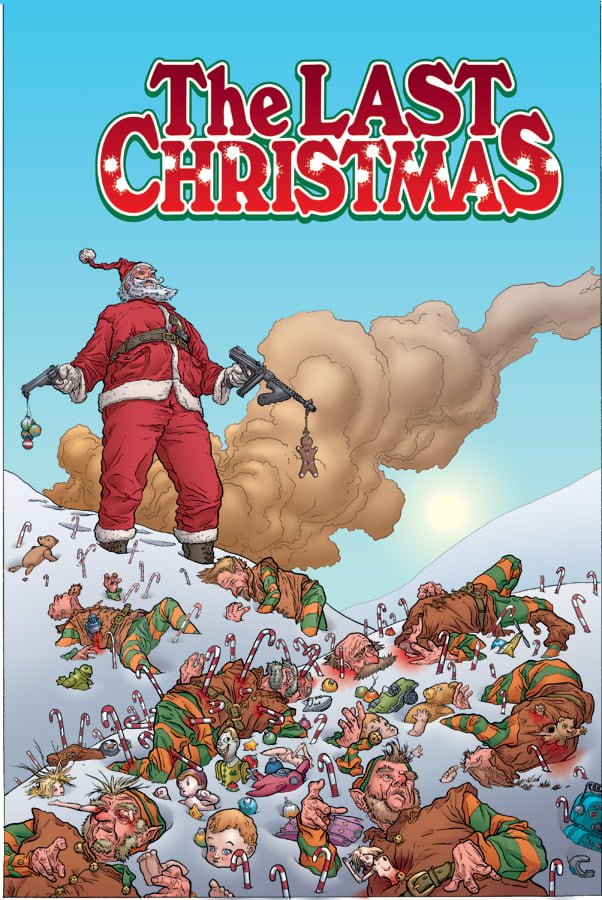Happy Holidays to everyone! In the spirit of the season, however you choose to celebrate, I’d like to share one of the weirdest holiday items out there (and yes, there are a surprising amount of entries to try and take this title, so that’s why I’ll call this “one of the weirdest” instead of definitively “the weirdest”… but I digress): the quirky graphic novel “The Last Christmas.”
“The Last Christmas” is a five-issue mini-series published by Image Comics a little over a decade ago. The story was written by Gerry Duggan and Brian Posehn. Yes, this is the team that is currently writing “Deadpool” for Marvel Comics (mostly Duggan, with a little Posehn here and there), here together a little over a decade ago writing about Santa and the undead. Duggan is a long-time comic-book writer, and some might additionally recognize Posehn’s name from his stand-up comedy and minor roles in various recent movies and television series, most recently on multiple episodes of “The Big Bang Theory.” According to their thank-yous in the back of the graphic novel, the two creators said the idea for this story was “hatched by two idiots playing Halo,” and as well as they may be doing with the Merc With a Mouth these days, I’m sad to report that this is exactly what the book feels like – a haphazard story thrown together by someone who didn’t really think things through too thoroughly.
The story is full of missed opportunities, from the jokes that fall flat to the “Christmas” feel that should make the book so unique and special – for example, when Santa is kicking zombie ass, why is he using a machine gun when it would be so much more fun and original to see him wreak havoc with candy canes, oversized bows, and eggnog? The little inconsistencies throughout the book will nag at even a reader who usually doesn’t notice such things in an average story.
Overall, the book is fun to read and is entertaining in a very stylized way, but the entertainment mostly stems from the pairing of the apocalypse, zombies, and Santa being so unique. The actual story is disjointed at times; some stories leave the reader to fill things in on their own, relying on the reader’s ability to understand the story and where it’s trying to go, but this story asks readers to fill in the blanks because they have no other choice, the story simply won’t do it for them. Duggan and Posehn are genuinely funny men, but unfortunately their entertainment value didn’t translate too well in this story.
The series scores fairly high marks in the unique/original realm, as not many other media, in any form, really attempts to tackle a story with Santa Claus and zombies, or at least they didn’t at the time of this series’ release (since 2006, though, holiday zombie stories have has grown in popularity slightly since, which is a phrase I never thought I’d have to type out). If you remove Santa from the equation, this is a pretty standard zombie-apocalypse story, but the presence (or should I say…”presents?” Ah, Christmas puns, you never get old) of Jolly Old Saint Nick is what makes the story unique.
Yes, I know it seems kind of hypocritical to talk about “realism” in a story about Santa and zombies, but even the “normal” people in this story aren’t making a whole lot of sense. The main living faction seems to have a fairly well-fortified section of town where the zombies and mutants can’t get to them, but the humans seem to leave their safe zones frequently and for no meaningful reasons. And the storylines for the “fantastical” parts of the story don’t really hold up either: it’s clearly established early on that Santa can’t die if any children still believe in him (Santa is very unsuccessful in trying to kill himself), so why is Santa scared when the zombies and mutants attack him, and why does the story try to build suspense when Santa is “in trouble” when we know he’s not going to die? There are more inconsistencies, but I think you get the point. I wonder where the Image editors were when this story got the green-light to go to press.
The story is well-depicted and the images we get are bright and vibrant, but the style of the art really doesn’t match up with the kind of story being told. The story is visually presented in a very retro-kitschy style drawing – think old “Mad” Magazines and EC Comics – but it just makes the violence look too cartoon-y for the tone this story is trying to convey.
I wish I could give this quirky graphic novel a better report, but the story falls flat and leaves you wishing for the great story that could have been. Maybe if we all ask Santa very nicely, he could find it in his heart to bring us that story someday!

